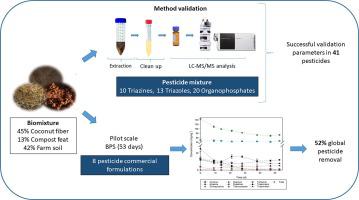Journal of Chromatography B ( IF 3 ) Pub Date : 2020-08-01 , DOI: 10.1016/j.jchromb.2020.122296 Mario Masís-Mora 1 , Wilson Beita-Sandí 1 , Javier Rodríguez-Yáñez 2 , Carlos E Rodríguez-Rodríguez 1

|
Biopurification systems are useful in the management of pesticide residues and provide an option to dispose wastewaters of agricultural origin derived from pesticide application practices. The analysis of pesticide residues in the biopurification system biomixture is necessary to determine whether the removal of the target compounds occurs with reliable results. In this study, the pesticide extraction methodology was optimized and validated in a biomixture composed of coconut fiber, compost and soil, to determine a total of 43 molecules, distributed among triazines (10), triazoles (13) and organophosphates (20) using liquid chromatography coupled to a triple quadrupole mass spectrometer. For the validation, the parameters of linearity, matrix effect, limit of determination (LOD), specificity, selectivity, precision, trueness and robustness in the proposed biomixture were evaluated. The analyses of those parameters revealed satisfactory results of the method for most of the compounds, with the exception of diclorvos and ciromazine, for which the development of an alternative method is recommended. Once the extraction methodology was validated, the removal of eight molecules was assayed in a biopurification system used for the simultaneous treatment of a mixture of pesticide commercial formulations. Although most of the compounds were at least partially removed, none of them was eliminated at levels below the LOD. The removal pattern of ametryn, atrazine, chlorpyrifos, malathion and terbutryn was comparable to those obtained in other efficient biomixtures, and the highly recalcitrant triadimenol was eliminated; nonetheless, tebuconazole and diazinon were not significantly removed.
中文翻译:

通过LC-MS / MS对生物纯化系统中三嗪,三唑和有机磷酸酯农药残留进行测定的方法学验证。
生物纯化系统可用于农药残留的管理,并提供了处置源自农药施用实践的农业来源废水的选择。必须对生物纯化系统生物混合物中的农药残留进行分析,以确定目标化合物的去除是否以可靠的结果进行。在这项研究中,农药提取方法在由椰子纤维,堆肥和土壤组成的生物混合物中进行了优化和验证,以确定总共43种分子,使用液体分布在三嗪(10),三唑(13)和有机磷酸盐(20)之间。色谱联用三重四极杆质谱仪。为了进行验证,需要使用以下参数:线性,基质效应,测定极限(LOD),特异性,选择性,精密度,评价了所提出的生物混合物的真实性和鲁棒性。对这些参数的分析显示,除双氯杀螨醇和环丙嗪外,大多数化合物的方法结果令人满意,建议开发另一种方法。一旦提取方法得到验证,就可以在用于同时处理农药商品制剂混合物的生物纯化系统中测定8种分子的去除。尽管大多数化合物至少已部分除去,但在低于LOD的水平上都没有消除它们。与其他有效生物混合物相比,六氢萘啶,at去津,毒死rif,马拉硫磷和特布丁的去除模式可比,并且消除了顽强的三苯三酚。尽管如此,



























 京公网安备 11010802027423号
京公网安备 11010802027423号